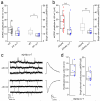TARP γ-7 selectively enhances synaptic expression of calcium-permeable AMPARs
- PMID: 23872597
- PMCID: PMC3858651
- DOI: 10.1038/nn.3473
TARP γ-7 selectively enhances synaptic expression of calcium-permeable AMPARs
Abstract
Regulation of calcium-permeable AMPA receptors (CP-AMPARs) is crucial in normal synaptic function and neurological disease states. Although transmembrane AMPAR regulatory proteins (TARPs) such as stargazin (γ-2) modulate the properties of calcium-impermeable AMPARs (CI-AMPARs) and promote their synaptic targeting, the TARP-specific rules governing CP-AMPAR synaptic trafficking remain unclear. We used RNA interference to manipulate AMPAR-subunit and TARP expression in γ-2-lacking stargazer cerebellar granule cells--the classic model of TARP deficiency. We found that TARP γ-7 selectively enhanced the synaptic expression of CP-AMPARs and suppressed CI-AMPARs, identifying a pivotal role of γ-7 in regulating the prevalence of CP-AMPARs. In the absence of associated TARPs, both CP-AMPARs and CI-AMPARs were able to localize to synapses and mediate transmission, although their properties were altered. Our results also establish that TARPed synaptic receptors in granule cells require both γ-2 and γ-7 and reveal an unexpected basis for the loss of AMPAR-mediated transmission in stargazer mice.
Figures







Similar articles
-
Channel properties reveal differential expression of TARPed and TARPless AMPARs in stargazer neurons.Nat Neurosci. 2012 Jun;15(6):853-61. doi: 10.1038/nn.3107. Nat Neurosci. 2012. PMID: 22581185 Free PMC article.
-
Stargazin (TARP gamma-2) is required for compartment-specific AMPA receptor trafficking and synaptic plasticity in cerebellar stellate cells.J Neurosci. 2011 Mar 16;31(11):3939-52. doi: 10.1523/JNEUROSCI.5134-10.2011. J Neurosci. 2011. PMID: 21411637 Free PMC article.
-
TARP γ-2 Is Required for Inflammation-Associated AMPA Receptor Plasticity within Lamina II of the Spinal Cord Dorsal Horn.J Neurosci. 2017 Jun 21;37(25):6007-6020. doi: 10.1523/JNEUROSCI.0772-16.2017. Epub 2017 May 30. J Neurosci. 2017. PMID: 28559374 Free PMC article.
-
Transmembrane AMPA receptor regulatory proteins and AMPA receptor function in the cerebellum.Neuroscience. 2009 Sep 1;162(3):656-65. doi: 10.1016/j.neuroscience.2009.01.004. Epub 2009 Jan 13. Neuroscience. 2009. PMID: 19185052 Free PMC article. Review.
-
Exploring the role of AMPA receptor auxiliary proteins in synaptic functions and diseases.FEBS J. 2025 May;292(10):2433-2478. doi: 10.1111/febs.17287. Epub 2024 Oct 11. FEBS J. 2025. PMID: 39394632 Review.
Cited by
-
The miR-124-AMPAR pathway connects polygenic risks with behavioral changes shared between schizophrenia and bipolar disorder.Neuron. 2023 Jan 18;111(2):220-235.e9. doi: 10.1016/j.neuron.2022.10.031. Epub 2022 Nov 14. Neuron. 2023. PMID: 36379214 Free PMC article.
-
More than a pore: ion channel signaling complexes.J Neurosci. 2014 Nov 12;34(46):15159-69. doi: 10.1523/JNEUROSCI.3275-14.2014. J Neurosci. 2014. PMID: 25392484 Free PMC article. Review.
-
Auxiliary subunits: shepherding AMPA receptors to the plasma membrane.Membranes (Basel). 2014 Aug 8;4(3):469-90. doi: 10.3390/membranes4030469. Membranes (Basel). 2014. PMID: 25110960 Free PMC article. Review.
-
Superactivation of AMPA receptors by auxiliary proteins.Nat Commun. 2016 Jan 8;7:10178. doi: 10.1038/ncomms10178. Nat Commun. 2016. PMID: 26744192 Free PMC article.
-
Synapse-specific expression of calcium-permeable AMPA receptors in neocortical layer 5.J Physiol. 2016 Feb 15;594(4):837-61. doi: 10.1113/JP271394. Epub 2015 Dec 17. J Physiol. 2016. PMID: 26537662 Free PMC article.
References
Publication types
MeSH terms
Substances
Grants and funding
LinkOut - more resources
Full Text Sources
Other Literature Sources
Molecular Biology Databases
Miscellaneous

